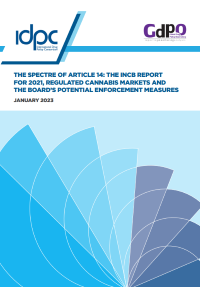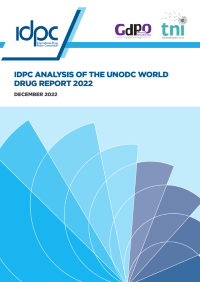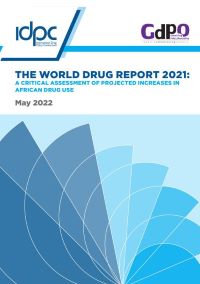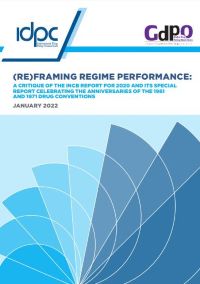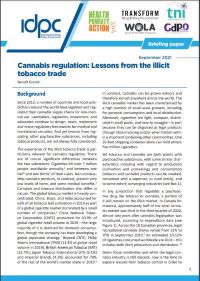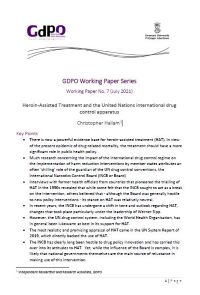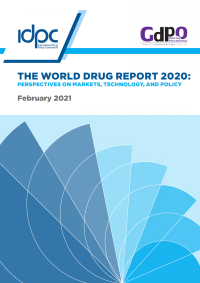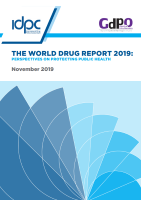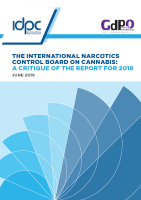It is widely accepted that the so-called ‘Vienna Consensus’ on drug policy is fractured. The UN based international drug control regime is coming under increasing scrutiny from not only sectors of civil society, but also - crucially – from a growing number of Parties to the conventions upon which the regime is based. Recent years have witnessed mounting debate on the operation of the existing regime and often tense and divisive discussion on how best to deal with an increasingly complex and sizable global illicit drug market. Significant legal tensions also currently surround the status of regulated recreational cannabis markets in several states; an issue that has implications beyond Vienna. The GDPO’s R2M project aims to improve understanding of regime dynamics and evolution and, promoting a health and rights based approach to drug policy, contribute to the reform and modernisation of the extant regime within the boundaries of international law.
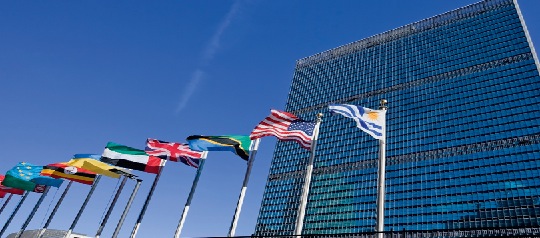

All GDPO material published on this website is licensed under a CC-BY Creative Commons Attribution 4.0 International License.
ANALYSIS OF THE WORLD DRUG REPORT 2023: THE PROMISE AND PERIL OF GOING GREEN
IDPC, Viso Mutop & GDPO, January 2024
With a format including not only the continued use of separate booklets, but also a new complementary online web-based element, the World Drug Report 2023 presents – as ever – an impressive array of largely accessible and user-friendly data and analysis of what the United Nations Office on Drugs and Crime (UNODC or Office) continues to refer to as the ‘world drug problem’. In so doing, readers can identify many familiar and predominantly alarming trends regarding the growing scale and increasing complexity of the illegal drug market. We are also informed, again, of ongoing inequalities relating to a range of official responses and policy interventions, including the availability of pharmaceutical opioids for medical consumption and significant barriers to treatment.
Read the full report here: Analysis of the World Drug Report 2023: The promise and peril of going green
THE INCB REPORT FOR 2022, REGULATED CANNABIS MARKETS
AND INTERNATIONAL LEGAL TENSIONS: A MISSED OPPORTUNITY
IDPC & GDPO, July 2023
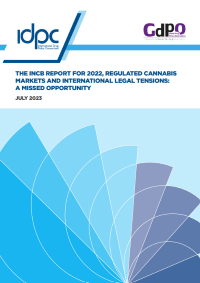
In its Annual Report for 2022, the International Narcotics Control Board (INCB or Board) once again presents an impressive overview of the state of international drug control relative to the provisions of the UN drug control conventions. It identifies several familiar themes and issues and includes a welcome ongoing focus on ensuring the availability of controlled substances for medical and scientific purposes. Indeed, although not without its problems, it is positive to see the Board continue to highlight the importance of human rights in the implementation of a range of drug control policies.
Read the full report here: THE INCB REPORT FOR 2022, REGULATED CANNABIS MARKETS
THE SPECTRE OF ARTICLE 14:
THE INCB REPORT FOR 2021, REGULATED CANNABIS MARKETS AND THE BOARD’S POTENTIAL ENFORCEMENT MEASURES
IDPC & GDPO, January 2023
With COVID-19 continuing to overshadow many aspects of contemporary life, it is no surprise that the pandemic is a constant theme within the Report of the International Narcotics Control Board (INCB or Board – see Box 1) for 2021.1 Not only is it given prominence at the very start of the foreword by the Board’s President, Ms. Jagjit Pavadia, but it is also evident throughout what is yet again a very thorough analysis of the world drug situation and countries’ responses to it. As with a range of other issues in recent years, the Board explicitly frames its response to COVID-19 in terms of both achieving the objectives of the international drug control conventions as well as contributing to broader UN programmes such as the Sustainable Development Goals (SDGs).
Read the full report here: THE SPECTRE OF ARTICLE 14: THE INCB REPORT FOR 2021
THE WORLD DRUG REPORT 2021:
IDPC ANALYSIS OF THE UNODC WORLD DRUG REPORT 2022
IDPC & GDPO, December 2022
As in previous years, the 2022 World Drug Report provides an impressive range of data and analysis on the so-called ‘world drug problem’.1 Following an overall summary of findings, points of interest, regional highlights, conclusions and policy implications in Booklet 1, Booklet 2 offers a global overview of drug demand and supply. Booklets 3 and 4 then analyse drug market trends, one focusing on cannabis and opioids, while the other covers cocaine, amphetamine-type stimulants and new psychoactive substances. Finally, this year’s thematic chapter, included in Special Booklet 5, provides a welcome analysis of the interrelationship between drugs and the environment.
Read the full report here: IDPC ANALYSIS OF THE UNODC WORLD DRUG REPORT 2022
THE WORLD DRUG REPORT 2021:
A CRITICAL ASSESSMENT OF PROJECTED INCREASES IN AFRICAN DRUG USE
IDPC & GDPO, May 2022
The 2021 World Drug Report provides a comprehensive analysis of trends in global drug markets, including production, trafficking, consumption and health consequences within the context of COVID-19, and highlights current and future impacts of the pandemic on drug market dynamics. An interesting component of the 2021 Report is the projected increase in the population of people who use drugs by 2030, in particular as it relates to the African continent. As shown in the Report and the Methodological Annex, the projection is based on limited and uncertain data. In this critique, we analyse the limitations of the data and methodologies, and explore the implications of the estimate for drug policy in Africa.
Read the full report here: THE WORLD DRUG REPORT 2021
(RE)FRAMING REGIME PERFORMANCE:
A CRITIQUE OF THE INCB REPORT FOR 2020 AND ITS SPECIAL REPORT CELEBRATING THE ANNIVERSARIES OF THE 1961 AND 1971 DRUG CONVENTIONS
IDPC & GDPO, January 2022
David Bewley-Taylor
With 2021 marking significant anniversaries of two of the core UN drug control conventions, the International Narcotics Control Board (INCB or Board, see Box 1) supplemented its Annual Report for 20201 (launched in March 2021) with a special commemorative publication, Celebrating 60 Years of the Single Convention on Narcotic Drugs of 1961 ‘… a generally acceptable international convention …’ and 50 Years of the Convention on Psychotropic Substances of 1971 ‘… an international convention is necessary …’. 2 While both are self-contained, several familiar themes can be discerned across the documents.
Read the full report: (RE)FRAMING REGIME PERFORMANCE
Cannabis regulation: Lessons from the illicit tobacco trade
IDPC, WOLA, TNI, Health Poverty Action, Transform Drug Policy Foundation, GDPO, September 2021
Benoît Gomis
Since 2013, a number of countries and local jurisdictions around the world have legalised and regulated their cannabis supply chains for non-medical use. Lawmakers, regulators, researchers, and advocates continue to design, enact, implement and revise regulatory frameworks for medical and recreational cannabis. And yet lessons from regulating other psychoactive substances, including tobacco products, are not always fully considered.
Read the full report here: Cannabis regulation: Lessons from the illicit tobacco trade
Heroin-Assisted Treatment and the United Nations international drug control
GDPO Working Paper 7, July 2021
Christopher Hallam
- There is now a powerful evidence base for heroin-assisted treatment (HAT). In view of the present epidemic of drug-related mortality, the treatment should have a more significant role in public health policy.
- Much research concerning the impact of the international drug control regime on the implementation of harm reduction interventions by member states attributes an often ‘chilling’ role of the guardian of the UN drug control conventions, the International Narcotics Control Board (INCB or Board)
- Interviews with former health officials from countries that pioneered the trialling of HAT in the 1990s revealed that while some felt that the INCB sought to act as a break on the intervention, others believed that - although the Board was generally hostile to new policy interventions - its stance on HAT was relatively neutral.
- In recent years, the INCB has undergone a shift in tone and outlook regarding HAT, changes that took place particularly under the leadership of Werner Sipp.
- However, the UN drug control system, including the World Health Organisation, has in general been lukewarm at best in its support for HAT.
- The most realistic and promising appraisal of HAT came in the UN System Report of 2019, which directly backed the use of HAT.
- The INCB has clearly long been hostile to drug policy innovation and has carried this over into its attitudes to HAT. Yet, while the influence of the Board is complex, it is likely that national governments themselves are the main source of reluctance in making use of this intervention.
Read the full Working Paper: Heroin-Assisted Treatment and the United Nations international drug control appa
Edging forward: How the UN’s language on drugs has advanced since 1990 (V2)
A previous version of this paper is available here.
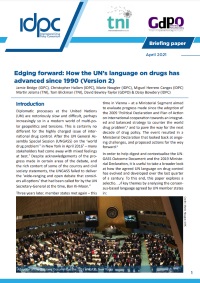
IDPC, TNI & GDPO, April 2021
By Jamie Bridge (IDPC), Christopher Hallam (IDPC), Marie Nougier (IDPC), Miguel Herrero Cangas (IDPC), Martin Jelsma (TNI), Tom Blickman (TNI), David Bewley-Taylor (GDPO) & Daisy Bowdery (IDPC)
Diplomatic processes at the United Nations (UN) are notoriously slow and difficult, perhaps increasingly so in a modern world of multi-polar geopolitics and tensions. This is certainly no different for the highly charged issue of international drug control. After the UN General Assembly Special Session (UNGASS) on the ‘world drug problem’ in New York in April 2016 – many stakeholders had come away with mixed feelings at best. Despite acknowledgements of the progress made in certain areas of the debate, and the rich content of some of the country and civil society statements, the UNGASS failed to deliver the ‘wide-ranging and open debate that considers all options’ that had been called for by the UN Secretary-General at the time, Ban Ki-Moon.
Three years later, member states met again – this time in Vienna – at a Ministerial Segment aimed to evaluate progress made since the adoption of the 2009 ‘Political Declaration and Plan of Action on international cooperation towards an integrated and balanced strategy to counter the world drug problem’, and to pave the way for the next decade of drug policy. The event resulted in a Ministerial Declaration that looked back at ongoing challenges, and proposed actions for the way forward.
In order to help digest and contextualise the UNGASS Outcome Document and the 2019 Ministerial Declaration, it is useful to take a broader look at how the agreed UN language on drug control has evolved and developed over the last quarter of a century.
Read the full briefing paper: Edging forward: How the UN’s language on drugs has advanced since 1990 (V2)
The World Drug Report 2020: Perspectives on markets, technology, and policy
IDPC response to the 2020 World Drug Report
IDPC & GDPO, February 2021
By Dave Bewley-Taylor & Patrick Shoirtis
UNODC’s 2020 World Drug Report provides a comprehensive and sophisticated analysis of the current state of global drug markets, as their size, complexity and intricacy continue to grow. However, the Report can be criticised for turning a blind eye on the negative consequences of states’ drug control efforts, and for overestimating the success of law enforcement approaches.
To explore these shortcomings, this year’s critique analyses the World Drug Report’s approach to the key topic of technological innovation in drug policy, through a close reading of its sections on cryptomarkets, and on the eradication of crops destined for the illegal drug market in Colombia.
In global drug policy debates, technological innovation is often framed as an instrument for disruption and as a cause of concern, if not alarm. That is certainly the approach adopted by the 2020 World Drug Report, which predominantly describes technological developments as a ‘challenge’ from the perspective of law enforcement. While there is some truth in this perspective, the reality is far more complicated with the use of technology by both state and non-state actors generating both positive and negative outcomes.
Read the full report: THE WORLD DRUG REPORT 2020: PERSPECTIVES ON MARKETS, TECHNOLOGY, AND POLICY
Intl Narcotics Control Board on human rights: A critique of the report for 2019
IDPC & GDPO, December 2020
By Dave Bewley-Taylor
Recent years have seen the issue of human rights become an increasingly prominent feature of UN deliberations on drug-related matters. Much has changed since 2008, when the former United Nations Special Rapporteur on the right to the highest attainable standard of health described the disconnect between human rights and drug control within the UN system. In what has become the go-to phrase for any discussion of the issue, Paul Hunt stressed that it was ‘imperative that the international drug control system…and the complex international human rights system that has evolved since 1948, cease to behave as though they exist in parallel universes’. A cursory glance at a range of outputs from both the drug policy apparatus in Vienna and parts of the human rights system in Geneva reveals the extent to which these universes have been shifting to align. Recognition of the need to better integrate drug policy and ensure system-wide coherence can be identified in the positions of a range of bodies, including crucially the Secretary General’s Chief Executives Board, the highest level forum for coordination in the UN system, and the associated ‘United Nations system common position supporting the implementation of the international drug control policy through effective inter-agency collaboration’. As described by António Guterres, in November 2018 ‘the heads of the UN system came together to forge a common position on the question of global drug policy to advance security, development and human rights’.
Today the international Narcotics Control Board (INCB or Board, see Box 1) plays an ever more important role in this integrative process. In performing its treaty mandated function as a monitoring body for the implementation of the UN drug control conventions, the Board occupies a critical vantagepoint within the UN system from which to observe and comment upon the often fraught interface between the United Nations based international regimes for drug control and human rights. As with a variety of monitoring bodies across the UN system, it possesses limited power to sanction what it perceives to be errant states. Yet, the INCB does have a noteworthy ability to ‘name and shame’; a process to which its annual report is key. These documents contain ‘an analysis of the drug control situation world-wide so that Governments are kept aware of existing and potential situations that may endanger the objectives of the international drug control treaties’ and ‘draws the attention of Governments to gaps and weakness in national control and treaty compliance’. Pursuing a narrow interpretation of its remit as laid out within the Single Convention, for many years the Board’s position on human rights could be described as a prominent example of selective reticence. In this way, and epitomizing Hunt’s parallel universes, the INCB typically displayed an unwillingness to comment on important issues that appeared to be within its purview and thus warranted its attention. As is evident from the first few pages of the Report for 2019, however, its outlook has to some degree changed with the Board now choosing to highlight a range of human rights considerations within its annual publication.
Within this context, this IDPC-GDPO critique uses the Board’s most recent Report as an entry point to better understand the body’s current stance on human rights as they pertain to drug-related matters. Such an approach is underpinned by the view that the Reports can be seen to provide ‘valuable insight into the values and beliefs which underlie the Board’s approach to the problems with which it deals’. In order to appreciate the broader institutional environment within which the INCB’s evolving position must be located, discussion begins with a brief overview of the origins and advancement of human rights within the UN system. A more detailed account can be found in the annex. It then moves onto an exploration of the structural determinants underpinning the often problematic relationship between the two regimes, associated norms, and obligations. With the aim of charting the Board’s evolutionary – if not always linear – journey, detailed content analysis of the Report for 2019 is complemented by a lighter touch examination of reports dating back to 2007. The critique concludes that although progress has certainly been made, examples of selective reticence remain. Moreover, it is argued, while welcoming a positive shift in stance it must be acknowledged how inherent conflicts between drug policy and human rights within the UN system put very firm limits on the Board’s capacity for change.
Read the full report here: INTL NARCOTICS CONTROL BOARD ON HUMAN RIGHTS: A CRITIQUE OF THE REPORT FOR 2019
The World Drug Report 2019: Perspectives on protecting public health
The International Narcotics Control Board on Cannabis: A Critique of the Report
Including analysis of Chapter I and other sections of the Report as appropriate, this report aims to provide a critique of the Board’s discussion of cannabis.
Read the full report THE INTERNATIONAL NARCOTICS CONTROL BOARD ON CANNABIS: A CRITIQUE OF THE REPORT
El equilibrio entre la estabilidad y el cambio
La modificación inter se de los tratados de fiscalización de drogas de la ONU para facilitar la regulación del cannabis
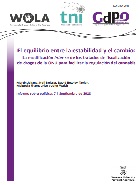 Informe sobre políticas 7, Septiembre de 2018
Informe sobre políticas 7, Septiembre de 2018
Martin Jelsma, Neil Boister, David Bewley-Taylor, Malgosia Fitzmaurice y John Walsh
El panorama de las políticas de drogas está atravesando un proceso de cambios profundos, en especial porque cada vez son más los países que avanzan hacia la regulación del mercado de cannabis. Esta realidad está aumentando las tensiones jurídicas en el seno del régimen internacional de fiscalización de drogas, un sistema basado en tratados y aceptado de forma casi universal, que actualmente se fundamenta en tres tratados pactados en 1961,1 19712 y 1988.3 Estos son ejemplos poco conocidos de los denominados ‘tratados para la eliminación’ que apuntalan una serie de regímenes prohibicionistas en el derecho internacional.4 El pilar del régimen en su forma actual, que se remonta a las primeras décadas del siglo XX, es la Convención Única de 1961 sobre Estupefacientes (modificada por el Protocolo de 1972).5 Al igual que en otros ámbitos temáticos, estas normas de derecho vinculante van acompañadas de instrumentos periódicos de derecho indicativo (Declaraciones políticas y variaciones de estas) y están respaldadas por varios organismos y agencias creados en virtud de los tratados con el fin de crear lo que se pretende que sea un marco jurídico con coherencia interna y que se autorrefuerce...
El informe completo está aquí: El equilibrio entre la estabilidad y el cambio La modificación inter se de los tratados de fiscalización de drogas de la ONU para facilitar la regulación del cannabis
Remarks: Allyn Taylor at 2018 CND side event
Friday, March 16, 2018
The prior panelists have made a concrete political and legal case for the codification of a treaty inter se to address the tension between state regulation of cannabis and commitments under the Single Convention on Narcotic Drugs. Dissatisfaction with the status of cannabis in the treaty system has long resulted has been described as “quiet revolution,” Today, however, the quiet revolution has turned into an all out revolt. With more and more direct treaty violations, the tensions between state cannabis policy and international law can no longer be ignored and viable options to maintain the integrity of the treaty system are highly limited. Recognizing the increasing polarization of policy debates in Vienna, there is simply no political will to resolve the challenges of cannabis reform within the treaty system....
Read the full post here
Regulating Cannabis in Accord with International Law: Options to Explore
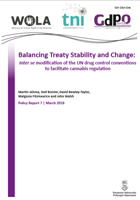 CND Side Event: Friday, March 16, 2018: Conference Room M5, 13:10-14:00
CND Side Event: Friday, March 16, 2018: Conference Room M5, 13:10-14:00
Joint WOLA, TNI, & GDPO Policy Report 7, March 2018
Martin Jelsma, Neil Boister, David Bewley-Taylor, Malgosia Fitzmaurice and John Walsh
As a growing number of countries move towards legal regulation for non-medical cannabis, governments are pushing the boundaries of the three UN drug control treaties. At the 61st session of the Commission on Narcotic Drugs (CND), TNI, the Washington Office on Latin America (WOLA) and the Global Drug Policy Observatory (GDPO) organised a side event to explore the issue, addressing the various challenges and opportunities involved. At the event a groundbreaking report on the issue will be presented: Balancing Stability and Change
Edging Forward: How the UN's language on drugs has advanced since 1990
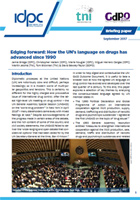 Joint IDPC, TNI, & GDPO Briefing Paper, September 2017
Joint IDPC, TNI, & GDPO Briefing Paper, September 2017
Jamie Bridge (IDPC), Christopher Hallam (IDPC & GDPO), Marie Nougier (IDPC), Miguel Herrero Cangas (IDPC), Martin Jelsma (TNI), Tom Blickman (TNI), & David Bewley-Taylor (GDPO)
Diplomatic processes at the United Nations (UN) are notoriously slow and difficult, perhaps increasingly so in a modern world of multi-polar geopolitics and tensions. This is certainly no different for the highly charged and provocative issue of international drug control. After the latest high-level UN meeting on drug control – the UN General Assembly Special Session (UNGASS) on the ‘world drug problem’ in New York in April 2016 – many stakeholders came away with mixed feelings at best. Despite acknowledgements of the progress made in certain areas of the debate, and the rich content of some of the country and civil society statements, the UNGASS failed to deliver the ‘wide-ranging and open debate that considers all options’ that had been called for by the UN Secretary-General at the time, Ban Ki-Moon. In order to help digest and contextualise the UNGASS Outcome document, it is useful to take a broader look at how the agreed UN language on drug control has devolved and developed over the last quarter of a century. To this end, this paper explores a selection of key themes by analysing the consensus-based language agreed by UN member states in several key declarations, statements, and outcome documents…
Read the full briefing here: Edging Forward How the UN's language on drugs has advanced since 1990
Dealing with Synthetics: Time to Reframe the Narrative
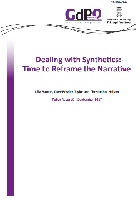 GDPO Policy Report 6, September 2017
GDPO Policy Report 6, September 2017
Julia Buxton, Dave Bewley-Taylor, and Christopher Hallam
History has, in many ways, deflected attention away from the issue of synthetic drugs. Governments and the overarching UN based international control structures above them have tended instead to traditionally focus their attentions on organic drugs and semi-synthetic substances derived from narcotic plants, such as opium, morphine, heroin, cannabis, coca and cocaine...inertia continues to afflict those structures responsible for developing appropriate policy responses...Policy Report 6 argues that considering its policy history and contemporary dynamics, it is now time to reframe the narrative surrounding the way the international community deals with synthetic drugs.
Read full briefing here: Dealing with Synthetics Time to Reframe the Narrative
UNGASS 2016: A Broken or B-r-o-a-d Consensus?
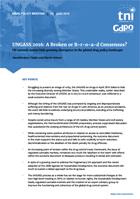 UN summit cannot hide growing divergence in the global drug policy landscape
UN summit cannot hide growing divergence in the global drug policy landscape
Drug Policy Briefing No.45, June 2016
David Bewley-Taylor and Martin Jelsma
The 30th Special Session of the General Assembly (UNGASS) took place in New York from 19 to 21 April. It was the third special session in UN history devoted to the drugs issue. During the previous drugs UNGASS in 1998, Mr Udovenko, the Ukrainian President of the General Assembly at the time, addressed in his closing remarks a “growing convergence of views” and a “spirit of togetherness”. The tough negotiations over the UNGASS outcome document this year, on the other hand, were characterised by growing divergence and head-on collision on some issues. A fragile consensus was reached on a final draft at the Commission on Narcotics Drugs (CND or Commission) in March in Vienna. Fears were so prevalent that it could still break apart in the course of the three-day meeting that the adoption of the outcome document, scheduled to take place at the closing session, was moved forward on the agenda immediately after the opening ceremony on the first day. When a journalist asked Mr Fedotov, the Executive Director of the United Nations Office on Drugs and Crime (UNODC), how the UN could pretend there is consensus on how to tackle what has become known simply as the ‘world drug problem’ when some countries are legalising cannabis while in others people are executed for trafficking it, he answered with a wry smile: “it’s a very b-r-o-a-d consensus”
Read the full briefing here: UNGASS 2016: A Broken or B-r-o-a-d Consensus?
Cannabis Regulation & the UN Drug Treaties: Strategies for Reform
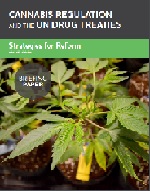 Briefing Paper Prepared by: GDPO, CDPC, HRDP, TDPF, TNI, WOLA, CHALN & MUCD, June 2016
Briefing Paper Prepared by: GDPO, CDPC, HRDP, TDPF, TNI, WOLA, CHALN & MUCD, June 2016
David Bewley-Taylor, Martin Jelsma, Steve Rolles, & John Walsh
As jurisdictions enact reforms creating legal access to cannabis for purposes other than exclusively “medical and scientific,” tensions surrounding the existing UN drug treaties and evolving law and practice in Member States continue to grow. How might governments and the UN system address these growing tensions in ways that acknowledge the policy shifts underway and help to modernize the drug treaty regime itself, and thereby reinforce the UN pillars of human rights, development, peace and security, and the rule of law?
Full Press Release here: Treaty Paper Press Release
Read the full report in English: Cannabis Regulation and the UN Drug Treaties
Watch the footage: 'Cannabis and the Conventions UNGASS and Beyond' at UNGASS 2016
Towards Metrics that Measure Outcomes that Matter
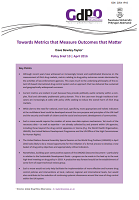
Dave Bewley-Taylor
Although recent years have witnessed an increasingly honest and sophisticated discourse on the measurement of illicit drug markets, metrics relating to drug policy outcomes remain dominated by the activities of law enforcement agencies. This owes much to the underlying philosophy of the extant UN based international drug control system and an approach that has delivered few sustained and geographically widespread successes. Current metrics are resilient in part because they provide politically useful certainty within a complex, fluid and ultimately problematic policy domain. This is the case even though traditional indicators are increasingly at odds with policy shifts seeking to reduce the overall harm of illicit drug markets. While alert to the need for national, even local, specificity, more appropriate and holistic indicators at the multilateral level could be developed around the core purpose and principles of the UN itself and the security and health of citizens and the social and economic development of communities. Such a move would require the creation of some new data capture mechanisms. Yet much of the necessary data – as well as expertise – are already collected by and present within UN agencies, including those beyond the drug control apparatus in Vienna (E.g. the World Health Organisation, UNAIDS, the United Nations Development Programme and the UN Office of the High Commissioner for Human Rights). The United Nations General Assembly Special Session on the World Drug Problem (UNGASS) in April 2016 looks likely to be a missed opportunity for the initiation of a formal process to develop a new basket of drug policy objectives and appropriately refined indicators. Nonetheless, building upon some positive aspects of the UNGASS Outcome Document – particularly in relation to the Sustainable Development Goals – progress can be made in the lead up to the next high-level meeting on drug policy in 2019. A productive way forward would be the establishment of some form of expert technical review group. Such a move would not only help facilitate the implementation of more effective and humane drug control policies and interventions at local, national, regional and international levels, but would also contribute to the reduction of continuing systemic dissonance around the issue of drug control within the UN system....
Read the full report here: Towards Metrics that Measure Outcomes that Matter
2016 United Nations General Assembly Special Session on the World Drug Problem
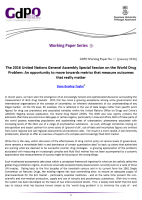
Dave Bewley-Taylor
The 2016 United Nations General Assembly Special Session on the World Drug Problem: An opportunity to move towards metrics that measure outcomes that really matter in recent years, we have seen the emergence of an increasingly honest and sophisticated discourse surrounding the measurement of illicit drug markets. With this has come a growing acceptance among some governments and international organisations of the concept of uncertainty; an inherent characteristic of our understanding of any illegal market. At the UN level, for example, this is reflected in the use of data ranges rather than specific point figures for drug use prevalence and associated variables within the United Nations Office on Drugs and Crime’s (UNODC) flagship annual publication, the World Drug Report (WDR). The WDR also now openly contains the admission that there are enormous data gaps in certain regions, particularly in Asia and Africa. Both of these parts of the world possess expanding populations and accelerating rates of urbanization, phenomena associated with increasing levels of the illicit use of a range of psychoactive substances. As such, although sometimes relying on extrapolation and expert opinion for some sense of ‘ground truth’, out-of-date and incomplete figures are omitted from some regional and sub-regional assessments of prevalence rates. The result is a more candid, if still inherently problematic, attempt to offer an overview of aspects of a complex and increasingly fluid illicit market.
Read the full paper here: GDPO UNGASS Metrics Working Paper Jan 2016
International Law and Drug Policy Reform Expert Seminar
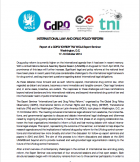
The Expert Seminar “International Law and Drug Policy Reform,” organized by The Global Drug Policy Observatory (GDPO), International Centre on Human Rights and Drug Policy (ICHRDP), Transnational Institute (TNI) and the Washington Office on Latin America (WOLA), took place in Washington, D.C., on 17-18 October 2014.
Drug policy reform is currently higher on the international agenda than it has been in recent memory. With a United Nations General Assembly Special Session (UNGASS) on drugs set for 19-21 April 2016, the prominence of this issue will further increase. Significant legal and policy reforms at the national level have taken place in recent years that pose considerable challenges to the international legal framework for drug control, and beg important questions regarding states’ international legal obligations.
As these debates move forward and as such reforms expand, international drug control law, often regarded as distant and arcane, becomes a more immediate and tangible concern. Clear legal tensions and, in some cases, breaches, are evident. The responses to these challenges will have ramifications beyond national borders and into international relations, and beyond international drug control law and into the broader realm of public international law.
Read the full report here: International Law and Drug Policy Reform Expert Seminar
Drugs and Development: The Great Disconnect
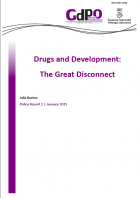 GDPO Policy Brief 2, January 2015
GDPO Policy Brief 2, January 2015
Julia Buxton
The 2016 United Nations General Assembly Special Session on the World Drug Problem (UNGASS) will see a strong lobby in support of development oriented responses to the problem of drug supply, including from the United Nations Office on Drugs and Crime (UNODC). The promotion of Alternative Development (AD) programmes that provide legal, non-drug related economic opportunities for drug crop cultivators reflects the limited success of enforcement responses, greater awareness of the development dimensions of cultivation activities and the importance of drugs and development agencies working co-operatively in drug environments. Evidence from thirty years of AD programming demonstrates limited success in supply reduction and that poorly monitored and weakly evaluated programmes cause more harm than good. UNGASS 2016 provides an opportunity for critical scrutiny of AD and the constraints imposed by the 1961 Single Convention on Narcotic Drugs on innovative, rights based and nationally owned supply responses. Cultivation is a development not a crime and security issue.
Read the full report here: Drugs and Development The Great Disconnect
Click here to read an abridged version of the report: Drugs and Development (abridged)
The Rise and Challenge of Dark Net Drug Markets
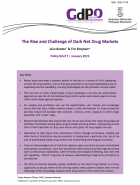 GDPO Policy Brief 7, January 2015
GDPO Policy Brief 7, January 2015
Julia Buxton & Tim Bingham
Recent years have seen a dramatic growth in the sale of a variety of illicit substances on Dark Net drug markets, with on line sales projected to increase exponentially due to expanding internet availability, evolving technologies and the profusion of social media. Experience to date shows that enforcement efforts through surveillance, hacking and other forms of interdiction may be successful in closing down a particular site, but at the cost of proliferating hidden drug markets and incentivising technological innovation. Dark Net interdiction efforts should prioritise high-end crimes such as child sexual exploitation, cyber terrorism and weapons trafficking, and work with self-regulating, ‘ethical’ drug sites to enhance understanding of high-level criminality on the Dark Net.
Read the full brief here: The Rise and Challenge of Dark Net Drug Markets
Getting High on Impact: The Challenge of Evaluating Drug Policy
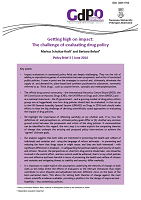
Schultze-Kraft, M. & Befani, B.
The official drug control community – the International Narcotics Control Board (INCB), the UN Commission on Narcotic Drugs (CND), the UN Office on Drugs and Crime (UNODC) and – at a national state level – the US government – and a growing number of drug policy reform groups are at loggerheads over how drug policies should best be evaluated. This brief highlights the importance of reflecting carefully on (a) whether and, if so, how the definitions of, and perceptions on, ultimate policy goals differ or (b) whether any common ground exists between the proponents and critics of the drug policies.
From Drug War to Culture War: Russia's Growing Role in the Global Drug Debate
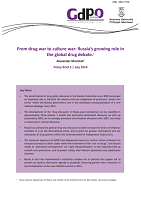
Alexander Marshall
Russia has utilized the general drug war discourse to both increase the levers of influence available to it on the international arena, and to press for greater convergence and harmonisation of drug policies within the Commonwealth of Independent States (CIS). The imminent departure of NATO from Afghanistan has led to further reform of Russia’s attempted outreach to other states within the framework of the ‘war on drugs’; the Russian model of ‘alternative development’ via ‘rapid industrialization’ is now explicitly held up as both more productive, and of greater utility, than Western-sponsored crop substitution schemes. Russia has also implemented a relatively complex set of policies that appear set to present an alternative agenda to proposals favouring greater harm reduction or decriminalisation at the next UNGASS summit in 2016.
Read the full report here: From drug war to culture war Russia's growing role in the global drug debate


